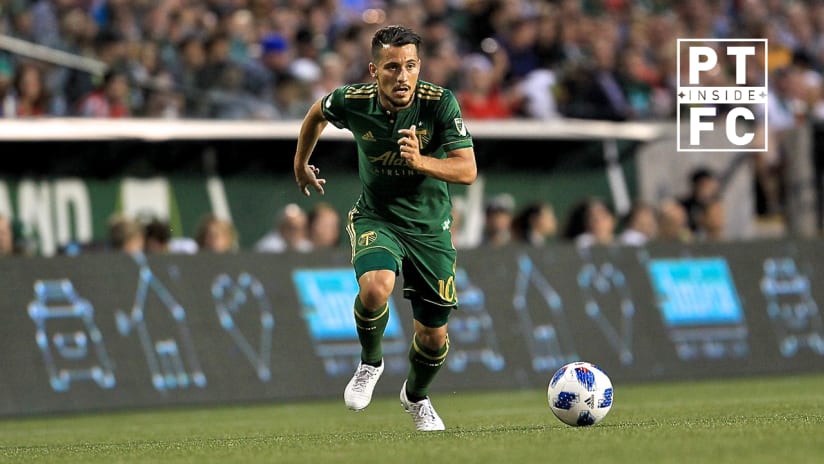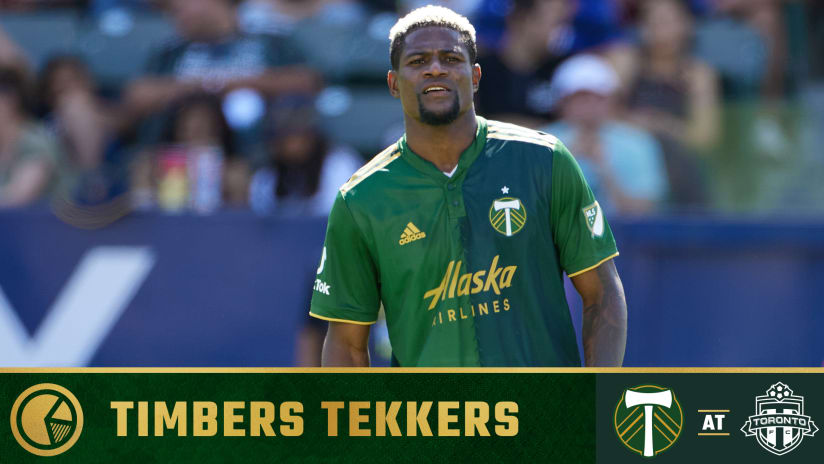Portland Timbers soccer analyst Ross Smith, on last week's Timbers in 30, had Liam Ridgewell go through it: the various passes the center back has in his arsenal, getting him to describe how and when he makes his various decisions in distribution. Along the way, the duo highlighted an array of skills we rarely talk about with center backs. When you stop and think about it, of course, the ability to play a good pass -- or, in Ridgewell's case, a variety of them -- is a desirable skill, but a center back's play are typically far down the passing chains that lead to goals, we rarely stop, dissect a center back's choice, and assess those decisions in terms of the chances they lead to.
Beyond Ridgewell's insight, an interesting part of the video is the man he's targeting with each of his passes. In the past, much of the Timbers' defenders' short play would look for Darlington Nagbe, or perhaps Diego Chara, while the direct options would always find the feet and heads of Fanendo Adi and Diego Valeri. Ridgewell even mentioned Rodney Wallace during his segment, a winger on the Timbers' MLS Cup-winning team that left Portland three years ago. But amid the various passes Smith had clipped, one current Timber was the consistent target: Sebastián Blanco.
Blanco's production was front-and-center at the beginning of the season when he scored five goals in the Timbers' first nine games of the season, flashing a level of goalscoring that had elevated from his 2017 Timbers debut. That year, Blanco finished the season with eight goals and eight assists, giving his new team a strong return for their Designated Player investment, but over his first months under Giovanni Savarese, the Argentine attacker was even more potent. Perhaps the former San Lorenzo threat, once settled into his new home, would prove more of a scoring threat than 2017 had hinted?
Since then, Blanco's only scored once in 19 games, but to the eye, his impact on the Timbers' team has arguably increased, particularly when you consider how most of the team's dangerous chances have been created over their last three games. Dating back to the breakthrough goal against Toronto on Sept. 5 …
… to the late, near-miss by Lucas Melano in extra time against New England …
… to the two-assist night …
... Blanco posted against Colorado …
… the 30-year-old Lanús product has been the most important player in Portland's attack – the engine which, as Ridgewell noted, the team is looking for to take the team from its build-up phase into attack.
This, at season's onset, was not how things were supposed to unfold; at least, from outside the squad, it looked as if the Timbers had a number of other players to captain the attack, the most obvious of which being reigning Major League Soccer Most Valuable Player Diego Valeri. And to be sure, Valeri is still a foundation to Portland's attack, as his team lead in goals (10) and assists (10) attests. But between Valeri, Adi, and the then-newly signed Samuel Armenteros this winter cast a number of players as potentially definitional. Perhaps Blanco was always one of them, but the conversation focused on others.
That conversation, now, has to shift, but it has to also merge with a discussion that, since the season's onset, has lost some volume, thanks in part to Blanco. Whereas once we though the emergences of Andy Polo and Cristhian Paredes would pick up some of the connecting responsibilities Nagbe used shoulder, it's Blanco, as Ridgewell's analysis hints, that is starting to power the team. Perhaps he does it in a different way than Nagbe did, with the now-Atlanta United player spending more time in deeper places than Blanco, but with the team shifting its look between 2017 and now, the places where the Timbers need their connections most have shifted, too.
The Toronto game may have been the season's best example, so far. In the wake of the team's loss to the Seattle Sounders on Aug. 26, we talked about how much attention both Blanco and Valeri garnered, and how that opened up space in the middle of the field. Three days later, it was Armenteros garnering special attention, being the subject to what became a man-marking scheme opposite Michael Bradley, while Valeri became a decoy of sorts, drifting high on the right flank to open up space in the middle of the field.
Blanco would collect 54 passes that night, second on the team only to David Guzmán, who was operating in a much deeper, holding midfielder's role. The six chances Blanco created was as many as the rest of the Timbers combined, while the pass he made for Chara, above, helped end a Timbers scoring drought that had reached 278 minutes. In each of the two games that have followed (New England on Sept. 1; Colorado on Saturday), Blanco has led all midfielders and forwards in both assists, chances created, and touches. To the extent that there is a debate about who, of late, has been Portland's best attacking player, there's little as to who has been most-involved.
Part of this is the cyclical nature of soccer tactics. Teams start doing something defensively; oppositions adjust; which leads to those defense searching for and trying new ideas. Right now, that cycle is allowing Sebastián Blanco to find success, albeit in a different way than he found success at the beginning in the season. And in between? That cycle saw Blanco in central midfield, playing an entirely different, less stat-heavy role.
Now it's opponent's turn to adjust. As the examples above, show, Blanco is finding ways to consistently beat defenses, beating them in wide spaces on both sides of the field. That's combined with a through-the-middle presence which, as of now, makes him the most prolific creator of the team's attacking options.
Perhaps teams will continue to try and contain Diego Valeri first, but, as Blanco showed on Saturday, he's still capable of getting the league MVP involved. And, Toronto FC saw, those times Portland's all-time goals leader is kept off the scoresheet can, thanks to the team's current focal point, still leave opponents searching for solutions.













